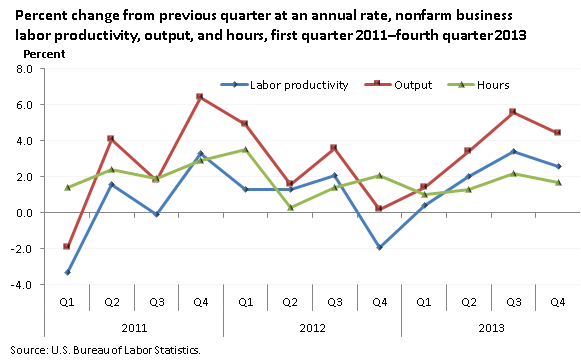An official website of the United States government
 United States Department of Labor
United States Department of Labor
Nonfarm business sector labor productivity increased at a 3.2-percent annual rate during the fourth quarter of 2013, reflecting increases of 4.9 percent in output and 1.7 percent in hours worked. From the fourth quarter of 2012 to the fourth quarter of 2013, productivity increased 1.7 percent, as output and hours worked rose 3.3 percent and 1.6 percent, respectively.

| Quarter | Productivity | Output | Hours |
|---|---|---|---|
1st quarter 2011 | -3.3 | -1.9 | 1.4 |
2nd quarter 2011 | 1.6 | 4.1 | 2.4 |
3rd quarter 2011 | -0.1 | 1.8 | 1.9 |
4th quarter 2011 | 3.3 | 6.4 | 2.9 |
1st quarter 2012 | 1.3 | 4.9 | 3.5 |
2nd quarter 2012 | 1.3 | 1.6 | 0.3 |
3rd quarter 2012 | 2.1 | 3.6 | 1.4 |
4th quarter 2012 | -1.9 | 0.2 | 2.1 |
1st quarter 2013 | 0.4 | 1.4 | 1.0 |
2nd quarter 2013 | 2.0 | 3.4 | 1.3 |
3rd quarter 2013 | 3.4 | 5.6 | 2.2 |
4th quarter 2013 | 2.6 | 4.4 | 1.7 |
Unit labor costs in nonfarm businesses decreased 1.6 percent in the fourth quarter of 2013, as the 3.2-percent increase in productivity was larger than a 1.5-percent increase in hourly compensation. Unit labor costs fell 1.3 percent over the last four quarters.
These data are from the BLS Labor Productivity and Costs program; the data are seasonally adjusted and subject to revision. To learn more, see "Productivity and Costs — Fourth Quarter and Annual Averages 2013, Preliminary," (HTML) (PDF), news release USDL‑14‑0167. Labor productivity, or output per hour, is calculated by dividing an index of real output by an index of hours worked for all persons, including employees, proprietors, and unpaid family workers. BLS defines unit labor costs as the ratio of hourly compensation to labor productivity; increases in hourly compensation tend to increase unit labor costs, and increases in output per hour tend to reduce them.
Bureau of Labor Statistics, U.S. Department of Labor, The Economics Daily, Productivity and costs, fourth quarter 2013 at https://www.bls.gov/opub/ted/2014/ted_20140212.htm (visited December 24, 2025).

